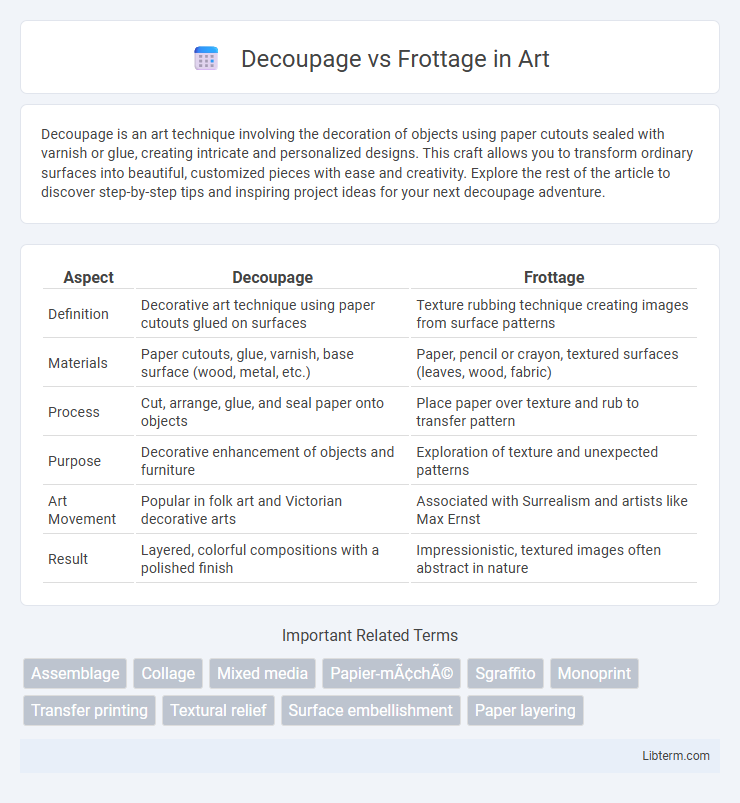Decoupage is an art technique involving the decoration of objects using paper cutouts sealed with varnish or glue, creating intricate and personalized designs. This craft allows you to transform ordinary surfaces into beautiful, customized pieces with ease and creativity. Explore the rest of the article to discover step-by-step tips and inspiring project ideas for your next decoupage adventure.
Table of Comparison
| Aspect | Decoupage | Frottage |
|---|---|---|
| Definition | Decorative art technique using paper cutouts glued on surfaces | Texture rubbing technique creating images from surface patterns |
| Materials | Paper cutouts, glue, varnish, base surface (wood, metal, etc.) | Paper, pencil or crayon, textured surfaces (leaves, wood, fabric) |
| Process | Cut, arrange, glue, and seal paper onto objects | Place paper over texture and rub to transfer pattern |
| Purpose | Decorative enhancement of objects and furniture | Exploration of texture and unexpected patterns |
| Art Movement | Popular in folk art and Victorian decorative arts | Associated with Surrealism and artists like Max Ernst |
| Result | Layered, colorful compositions with a polished finish | Impressionistic, textured images often abstract in nature |
Introduction to Decoupage and Frottage
Decoupage is a decorative art technique involving the cutting and gluing of paper cutouts onto surfaces, which are then coated with varnish or lacquer for a smooth, painted effect. Frottage involves creating textured rubbings by placing paper over a textured surface and rubbing with a pencil or crayon, capturing the surface's detailed patterns. Both techniques emphasize transforming ordinary objects into artistic pieces through distinct methods of layering and texture.
Historical Origins of Decoupage
Decoupage originated in 17th-century Europe, particularly in Italy and France, where it evolved as an art form involving the application of cut paper designs to furniture and objects to mimic intricate inlay work. This technique spread rapidly through aristocratic circles during the 18th century, gaining popularity as an affordable alternative to costly marquetry. Unlike frottage, which was developed by surrealists like Max Ernst in the 1920s as a textural rubbing technique, decoupage has deeper historical roots tied to decorative arts and craftsmanship in early modern Europe.
Frottage: Evolution and Background
Frottage, an artistic technique developed by surrealist Max Ernst in the 1920s, involves creating textures and images by rubbing a pencil or crayon over a textured surface. This method evolved as a means of tapping into the subconscious mind, capturing unexpected patterns that inspired imaginative compositions. Its background roots lie in early explorations of texture and automatism, positioning frottage as a significant innovation in modern art's exploration of chance and texture.
Key Materials Used in Decoupage
Decoupage primarily utilizes paper cutouts, glue (often Mod Podge), and varnish to create layered artistic designs on surfaces like wood or glass. Key materials include decorative paper or napkins, scissors for precise cutting, and sealing agents that protect and enhance the finished artwork. Unlike Frottage, which relies on textures transferred via rubbing, Decoupage focuses on adhesive layering and finishing techniques to achieve its distinctive visual effect.
Essential Tools for Frottage Art
Frottage art primarily requires textured surfaces, paper, and drawing tools such as pencils or charcoal to capture detailed rubbings. Essential items include organic materials like leaves or manhole covers and hard tools like wood or metal objects to create diverse textures. Unlike decoupage, frottage emphasizes the importance of varied textures and precise rubbing techniques to achieve artistic depth.
Techniques and Processes Compared
Decoupage involves cutting out paper designs and adhering them onto surfaces with layers of varnish to create a smooth, decorative finish, emphasizing precision and layering techniques. Frottage, by contrast, relies on placing paper over textured surfaces and rubbing with pencils or crayons to capture the underlying patterns, highlighting spontaneous texture extraction. Both techniques explore surface manipulation but differ fundamentally in approach: decoupage builds images through assembly, while frottage reveals images via impression.
Artistic Effects: Decoupage vs Frottage
Decoupage creates intricate, layered artistic effects by adhering cut-out images onto surfaces, allowing for vibrant, collage-like compositions with rich texture contrasts. Frottage produces subtle, tactile patterns through rubbing paper over textured objects, emphasizing organic, spontaneous marks and abstract visuals. Both techniques enhance surface complexity but differ in visual impact: decoupage offers detailed imagery while frottage emphasizes texture and randomness.
Popular Applications and Uses
Decoupage is widely used in home decor to personalize furniture, boxes, and trays with layered paper cutouts sealed by varnish, enhancing aesthetic appeal. Frottage finds popularity in fine art for creating textured rubbings from surfaces like wood, leaves, and coins, adding unique patterns to paintings and mixed media projects. Both techniques serve decorative purposes but cater to different creative effects, with decoupage emphasizing collage and frottage focusing on texture reproduction.
Advantages and Limitations of Each Technique
Decoupage offers advantages such as easy customization, a wide range of materials, and the ability to create detailed, layered designs, but it can be time-consuming and requires patience during the drying process. Frottage provides a quick, spontaneous texture-based effect by rubbing over surfaces, making it ideal for capturing unique, organic patterns, though it may lack precision and control over the final image. Both techniques complement different artistic goals, with decoupage excelling in decorative, polished aesthetics and frottage in experimental, textured expression.
Choosing Between Decoupage and Frottage
Choosing between decoupage and frottage depends on the desired artistic effect and materials available; decoupage involves decorating surfaces with cut-out paper designs glued and sealed for a polished, layered look, while frottage is a frottaged texture technique achieved by rubbing a pencil or crayon over paper placed on textured surfaces, emphasizing spontaneous patterns. Decoupage suits projects requiring detailed imagery and a smooth finish, commonly applied on wood, glass, or furniture, whereas frottage is ideal for abstract or experimental textures on paper or canvas. Evaluating project goals, surface type, and technique preference ensures selecting the most effective method for creative expression.
Decoupage Infographic

 libterm.com
libterm.com